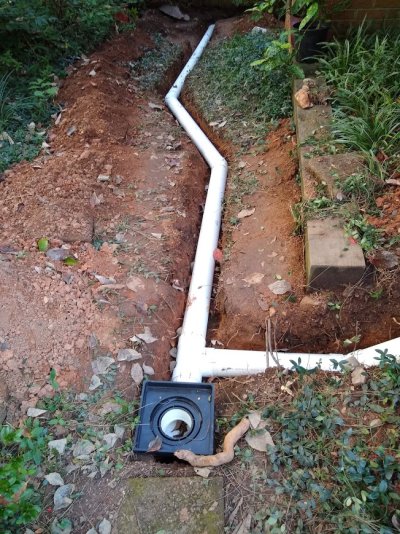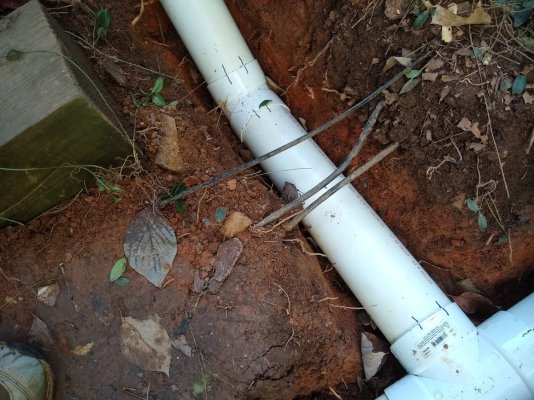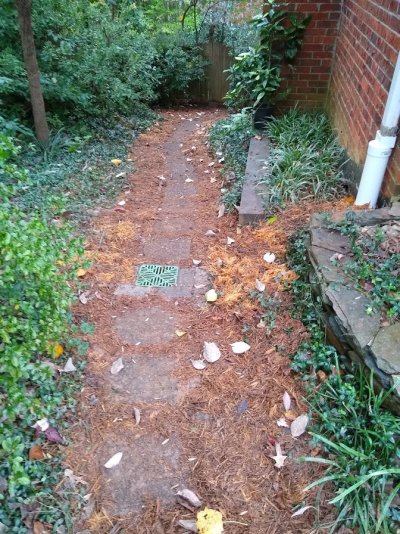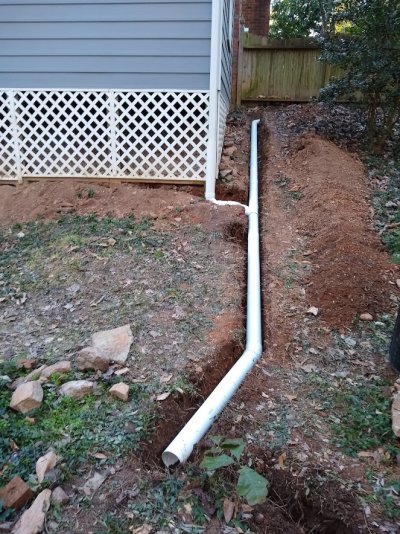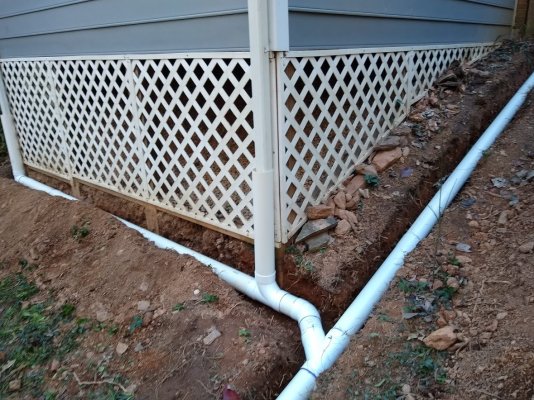JoeWras
Give me a museum and I'll fill it. (Picasso) Give me a forum ...
- Joined
- Sep 18, 2012
- Messages
- 11,702
It is a common DYI project around here: improve the drainage around your house. There have been some really nice postings through the years that inspired me.
But I wasn't too interested because I thought I did the work 25 years ago. I was wrong. My lines were non-functional. We had some recent rains that resulted in some serious soggy ground. I'm on a harsh slope, so this confused me. My drainage should have just taken away the water.
I did a test and found my line was 100% plugged. I tried flushing it, but the hose would not go in too far. On the ends, I couldn't see anything, yet I knew something was in there.
Yep. Roots.

These buggers are sneaky and insidious. You can't see them at the end because roots don't like light. So, they clog the middle. How do they get in the middle? Well, the smallest nick from a sharp rock will do it. And if you dare to join a seam, forget it! Game over. Here's a 1" root entering my pipe through an apparent nick I created, or which occurred during a frost heave:

I know it is so tempting to use this stuff. It is easy to work with. It is lightweight. It is flexible so your trenches don't have to be precise. There are a lot of positives.
The negatives are that it is not durable. It is easy to crush. It is prone to a shovel nick or rock nick. And if you live in an area with a lot of trees, then it will be game-over in a few years. And when it clogs, the corrugations make it nearly impossible to run a rod through.
Do use it for above ground situations. It worked great for me under a deck, for instance. It is also good for temporary situations. Don't bury it. OK, maybe if you live in a tree and bush free area, it might be OK. Otherwise, don't do it.
My replacement project is coming along. It is some of the hardest physical labor I've done in years. The area is tight and full of utilities, so I had to carefully hand dig. My soil type is "Ag", which is best described as large gravel with some organic matter thrown in. Whenever the home TV shows or blog articles show such a project, they pick some house with wonderful aerated sandy loam that a spade just falls into. That's not the real world! Not only did I have constant 1" stones, I had plenty of 6" versions too. Oh, and I found the 2 1/2 ft. circular mortar pile, which was 8" deep in the middle. I know where the bricklayers set up shop. It was like an archeological dig.
It takes some work to deal with the rigid pipe, but I think it will be worth it. You'll see I had to angle around a chimney foundation and utility dense area. The D2729 stuff is lightweight (much more so than schedule 40) and works fine as long as you are not running traffic over it. The D2729 also has a tiny bit of play making it easier to work with on long runs. There is also SDR-35 (green stuff) which is somewhere between D2729 and Sch 40. That's an excellent option if you can easily get it. I could not. In the end, the smooth walls will allow for better maintenance that corrugated could never give you.
Here's a picture of my first phase (side yard). Second phase will be in the back where I plan to release this into a new water garden. I'm pretty excited about the idea of the water garden, both to expand my garden skills, and help the environment.
But I wasn't too interested because I thought I did the work 25 years ago. I was wrong. My lines were non-functional. We had some recent rains that resulted in some serious soggy ground. I'm on a harsh slope, so this confused me. My drainage should have just taken away the water.
I did a test and found my line was 100% plugged. I tried flushing it, but the hose would not go in too far. On the ends, I couldn't see anything, yet I knew something was in there.
Yep. Roots.

These buggers are sneaky and insidious. You can't see them at the end because roots don't like light. So, they clog the middle. How do they get in the middle? Well, the smallest nick from a sharp rock will do it. And if you dare to join a seam, forget it! Game over. Here's a 1" root entering my pipe through an apparent nick I created, or which occurred during a frost heave:

I know it is so tempting to use this stuff. It is easy to work with. It is lightweight. It is flexible so your trenches don't have to be precise. There are a lot of positives.
The negatives are that it is not durable. It is easy to crush. It is prone to a shovel nick or rock nick. And if you live in an area with a lot of trees, then it will be game-over in a few years. And when it clogs, the corrugations make it nearly impossible to run a rod through.
Do use it for above ground situations. It worked great for me under a deck, for instance. It is also good for temporary situations. Don't bury it. OK, maybe if you live in a tree and bush free area, it might be OK. Otherwise, don't do it.
My replacement project is coming along. It is some of the hardest physical labor I've done in years. The area is tight and full of utilities, so I had to carefully hand dig. My soil type is "Ag", which is best described as large gravel with some organic matter thrown in. Whenever the home TV shows or blog articles show such a project, they pick some house with wonderful aerated sandy loam that a spade just falls into. That's not the real world! Not only did I have constant 1" stones, I had plenty of 6" versions too. Oh, and I found the 2 1/2 ft. circular mortar pile, which was 8" deep in the middle. I know where the bricklayers set up shop. It was like an archeological dig.
It takes some work to deal with the rigid pipe, but I think it will be worth it. You'll see I had to angle around a chimney foundation and utility dense area. The D2729 stuff is lightweight (much more so than schedule 40) and works fine as long as you are not running traffic over it. The D2729 also has a tiny bit of play making it easier to work with on long runs. There is also SDR-35 (green stuff) which is somewhere between D2729 and Sch 40. That's an excellent option if you can easily get it. I could not. In the end, the smooth walls will allow for better maintenance that corrugated could never give you.
Here's a picture of my first phase (side yard). Second phase will be in the back where I plan to release this into a new water garden. I'm pretty excited about the idea of the water garden, both to expand my garden skills, and help the environment.

